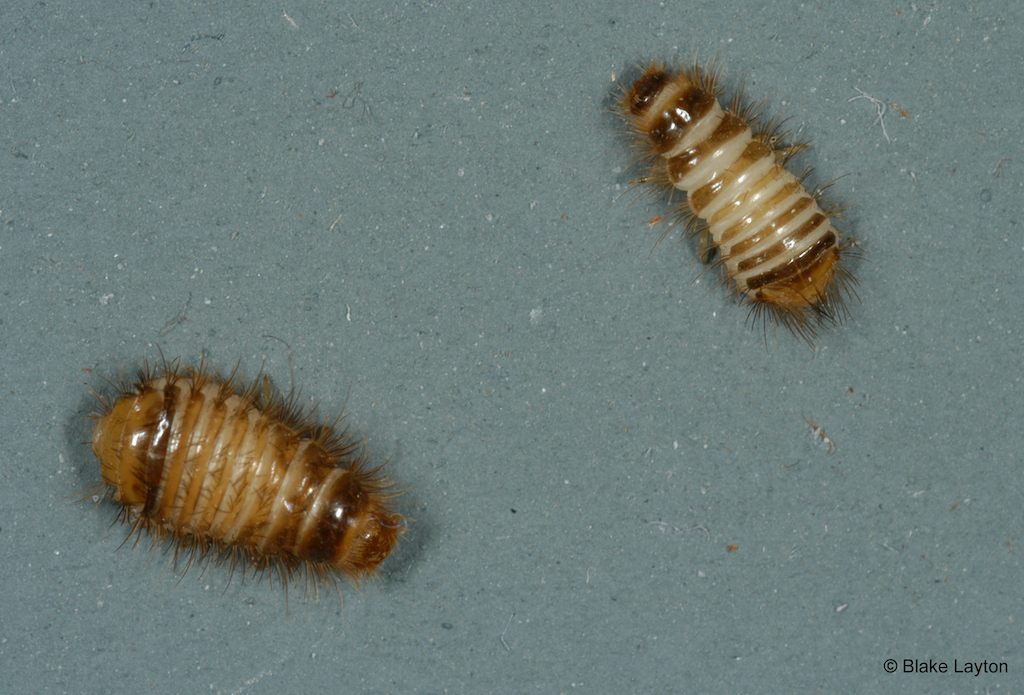Varied Carpet Beetle, Vol. 6, No. 2

Anthrenus verbasci
Order: Coleoptera
Family: Dermestidae
We keep finding these things in the bedroom; sometimes they are even in the bed. What are they and what do we need to do about them?
These are the larvae of varied carpet beetles. They feed on animal-based items such as hair, wool, hide, silk, feathers, accumulations of dead insects and similar dried, animal-based materials. Carpet beetles earned their name back when carpets really were made of wool. Carpet beetles continue to be significant pests of animal-based fabrics and are important pests of wool and silk clothing, antique rugs and tapestries, and museum specimens. They do not damage synthetic carpets, but they sometimes feed on carpets and other fabrics that contain a blend of synthetic and animal fibers, and they sometimes occur in dried, plant-based products. There are several species of carpet beetles, but varied carpet beetles are especially common.
Much of the “clothes moth damage” we see here in the south is really caused by carpet beetles. Susceptible items include wool clothing, wool sweaters, hanks of wool yarn, silk and wool tapestries, antique wool or silk rugs, felt hats, felt in pianos, furniture containing wool or hair, feathers or articles made of feathers, brushes made of animal hair, taxidermy mounts and similar items. Carpet beetles also feed on the dried bodies of dead insects and are common pests of insect collections. Heavy infestations frequently develop in accumulations of dead insects, such as often occur in light fixtures. Dried carcasses of small animals, such as rats, birds or squirrels, that have died in wall or ceiling voids also harbor infestations.
Adult varied carpet beetles are small black beetles with light-colored wavy lines running horizontally across their backs. Adults can be found feeding on pollen in outdoor flowers. They can be brought indoors on cut flowers but are also capable of invading homes on their own to search for suitable hosts. Once the larvae are fully grown, they usually wander away from the original point of infestation in search of a suitable place to pupate, and this is often when the larvae are first noticed. Adult beetles accumulating in windows or on windowsills are another sign of infestation.
Control: Control depends on finding and discarding or treating infested items, which is often easier said than done. When conducting your search, keep in mind that insects may be crawling from some item in the room or in a nearby closet, or they may be dropping from above, either from items stored in the attic or a second story room or closet, or from ceiling voids. Look for items made of susceptible materials, accumulations of shed larval skins, and active larvae and adults. Care should be used when cleaning up heavy infestations because hair from carpet beetle larvae can be irritating to skin and lungs and can cause problems if inhaled. Wear an appropriate respirator, use a vacuum with an approved HEPA filter, and limit exposure to the dust generated during cleanup.
See pages 20-23 of MSU Extension Publication 2443, Control Household Insect Pests , for more information on carpet beetles and their control: http://extension.msstate.edu/sites/default/files/publications/publications/p2443.pdf
Blake Layton, Extension Entomology Specialist, Mississippi State University Extension Service.
The information given here is for educational purposes only. Always read and follow current label directions. Specific commercial products are mentioned as examples only and reference to specific products or trade names is made with the understanding that no discrimination is intended to other products that may also be suitable and appropriately labeled.
Mississippi State University is an equal opportunity institution.

